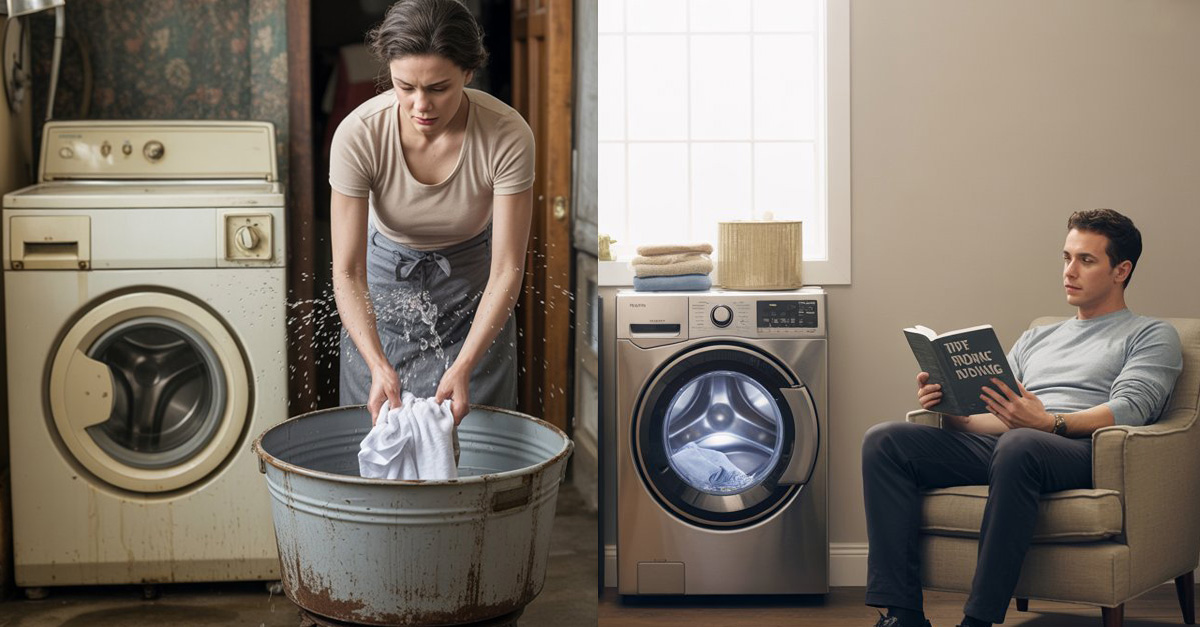The choice between a semi-automatic vs fully automatic washing machine is one of the most significant decisions when outfitting a home with essential appliances. It’s a choice that directly impacts your daily routine, your utility bills, and your budget. On one hand, the semi-automatic machine offers affordability and control; on the other, the fully automatic promises unparalleled convenience. So, how do you decide which laundry workhorse is the right fit for your household?
This complete guide will break down every aspect of the semi-automatic vs fully automatic washing machine debate. We will go beyond the surface-level differences to compare them on the factors that truly matter: water and electricity consumption, human effort, wash quality, and overall value for money, empowering you to make the best possible choice.
Table of Contents
The Head-to-Head Battle: Semi-Automatic vs Fully Automatic Washing Machine
Let’s break down the key differences across the most important categories for any homeowner.
Human Effort & Convenience
This is the biggest and most obvious difference. A semi-automatic washing machine requires manual intervention. It has two tubs: one for washing and one for spin-drying. After the wash cycle is complete, you must physically move the wet, heavy clothes from the wash tub to the spin tub.
A fully automatic washing machine, as the name implies, does everything for you. You simply load the clothes, add detergent, select a program, and press start. It washes, rinses, and spins dry all in the same drum without you needing to touch it until the cycle is completely finished.
- Winner: Fully Automatic (by a landslide)
Water Consumption
A semi-automatic washing machine gives you complete control over the water. You fill the tub manually, which means you can reuse the water for a second, less-soiled load if you wish. This can lead to significant water savings, especially in areas with water scarcity.
A fully automatic washing machine draws water directly from the tap and requires a continuous water supply. While modern models are becoming increasingly efficient, they generally use more water per cycle than a semi-automatic machine, as each stage (wash, rinse) uses a fresh batch of water.
- Winner: Semi-Automatic
Price and Budget
There is a clear winner here. Semi-automatic washing machines are considerably cheaper to purchase upfront. They are the go-to budget option for families, bachelors, and anyone looking for a functional machine without a hefty price tag.
Fully automatic washing machines, with their advanced technology, single-drum design, and numerous features, come with a higher initial cost.
- Winner: Semi-Automatic
Wash Quality and Features
Fully automatic washing machines offer a superior wash quality. They have multiple wash programs designed for different fabric types (cottons, woolens, delicates), built-in heaters for hot water washes to tackle tough stains, and more advanced tumbling actions that are gentler on clothes.
The wash action in a semi-automatic washing machine is more basic, with fewer customizable options. While effective for everyday clothes, it may not handle delicate fabrics as gently.
- Winner: Fully Automatic
Electricity Usage
This is a surprisingly close contest. While a fully automatic machine has more features, its cycles are often shorter and more efficient. A semi-automatic machine’s wash cycle might be shorter, but the total time (and thus electricity) used can be similar once you factor in the spinning cycle. According to guidelines from energy efficiency bodies like the Bureau of Energy Efficiency (BEE), looking at the star rating is more important than the machine type for determining electricity consumption.
- Winner: Tie (Check the Star Rating)
Size and Portability
Because they are made of plastic and are generally smaller, semi-automatic washing machines are lightweight and often come with wheels, making them easy to move around. This is a huge advantage for people living in rental homes. Fully automatic washing machines are heavy, bulky, and designed for permanent installation.
- Winner: Semi-automatic
Quick Comparison Table
| Feature | Semi-Automatic Machine | Fully Automatic Machine |
| Convenience | Low (Manual Effort Required) | High (Press & Go) |
| Water Usage | Low (Manual Control) | High (Continuous Supply) |
| Upfront Cost | Low | High |
| Wash Quality | Good | Excellent (Multiple Programs) |
| Portability | High (Lightweight & Mobile) | Low (Heavy & Stationary) |
The Final Verdict: Which One Should You Buy?
The best choice in the semi-automatic vs fully automatic washing machine debate depends entirely on your priorities.
You Should Buy a Semi-Automatic Washing Machine if…
- You are on a tight budget. It’s the most cost-effective way to get a washing machine.
- You live in an area with inconsistent water supply. The ability to manually fill the tub is a major advantage.
- You want to conserve water and don’t mind reusing rinse water for a second load.
- You move frequently and need a machine that is lightweight and portable.
You Should Buy a Fully Automatic Washing Machine if…
- Convenience is your absolute top priority. You value a “set it and forget it” lifestyle.
- You have a reliable, continuous water supply.
- You wash delicate or expensive clothes and need specialized wash programs.
- You want the best possible wash quality with features like hot water washing. If this is you, be sure to check out our detailed guide on the best fully automatic washing machines for our top model recommendations.
Conclusion
The decision in the semi-automatic vs fully automatic washing machine showdown is a classic trade-off: cost and control versus convenience and features. If your priority is saving money and resources, and you don’t mind a little manual work, the semi-automatic machine is a practical and brilliant choice. However, if your lifestyle demands efficiency, convenience, and the best possible care for your clothes, the higher initial investment in a fully automatic machine will pay for itself in time and effort saved every single day. For more guides on choosing the right appliances, explore our full category of home appliance reviews.

